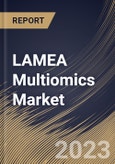Advances in single-cell sequencing technologies allow researchers to delve into the heterogeneity of cell populations, shedding light on intricate cellular dynamics and rare cell types. Artificial intelligence and machine learning are applied to evaluate complex multiomics data, identify trends, predict disease outcomes, and guide drug discovery. Monitoring changes in omics profiles in response to treatments or environmental factors is becoming increasingly crucial for personalized healthcare and precision medicine. This data is used to study the complex interactions between the human microbiome and various diseases, including metabolic disorders and autoimmune conditions.
As multiomics approaches become integral to healthcare and drug development, regulatory bodies are adapting to accommodate these techniques' unique challenges and opportunities. Emerging platforms and software solutions are streamlining the integration and analysis of multiomics data, making it more accessible to researchers. Its application in precision medicine is leading to the development of targeted therapies and diagnostic tools with the potential to improve patient outcomes. Initiatives promoting open access to omics data are accelerating research by providing comprehensive datasets for analysis and exploration. The fusion of multiomics with emerging fields like epigenomics, glycomics, and lipidomics is expanding the scope of multiomics research and its relevance to various industries.
The Middle East has seen an increasing interest in precision medicine, especially in countries like Qatar and the United Arab Emirates. Researchers in the region are conducting multiomics studies to understand the genetic and molecular factors contributing to conditions such as diabetes, cardiovascular diseases, and cancer. These studies aim to tailor healthcare and treatment plans to individual patients. South Africa is making strides in cancer genomics. Multiomics research is being used to understand better the genetic basis of different cancer types prevalent in the region, such as cervical cancer. This research will lead to more targeted therapies and improved cancer management. These factors pose lucrative growth prospects for the market in the LAMEA regions.
The Brazil market dominated the LAMEA Multiomics Market by Country in 2022 and would continue to be a dominant market till 2030; thereby, achieving a market value of $84.2 million by 2030. The Argentina market is registering a CAGR of 19.2% during (2023 - 2030). Additionally, The UAE market would showcase a CAGR of 18.2% during (2023 - 2030).
Based on Type, the market is segmented into Bulk Multiomics, and Single-cell Multiomics. Based on Product & Service, the market is segmented into Product (Instruments, Consumables, and Software), and Services. Based on End-use, the market is segmented into Academic & Research Institutes, Pharmaceutical & Biotechnology Companies, and Others. Based on Platform, the market is segmented into Genomics, Transcriptomics, Proteomics, Metabolomics, and Integrated Omics Platforms. Based on Application, the market is segmented into Cell Biology, Oncology, Neurology, and Immunology. Based on countries, the market is segmented into Brazil, Argentina, UAE, Saudi Arabia, South Africa, Nigeria, and Rest of LAMEA.
The market research report covers the analysis of key stake holders of the market. Key companies profiled in the report include Thermo Fisher Scientific, Inc, Illumina, Inc., Danaher Corporation, PerkinElmer, Inc., Bruker Corporation, Qiagen N.V., Agilent Technologies, Inc., BGI Group, Becton, Dickinson, and Company, Shimadzu Corporation.
Scope of the Study
Market Segments Covered in the Report:
By Type- Bulk Multiomics
- Single-cell Multiomics
- Product
- Instruments
- Consumables
- Software
- Services
- Academic & Research Institutes
- Pharmaceutical & Biotechnology Companies
- Others
- Genomics
- Transcriptomics
- Proteomics
- Metabolomics
- Integrated Omics Platforms
- Cell Biology
- Oncology
- Neurology
- Immunology
- Brazil
- Argentina
- UAE
- Saudi Arabia
- South Africa
- Nigeria
- Rest of LAMEA
Key Market Players
List of Companies Profiled in the Report:
- Thermo Fisher Scientific, Inc
- Illumina, Inc.
- Danaher Corporation
- PerkinElmer, Inc.
- Bruker Corporation
- Qiagen N.V.
- Agilent Technologies, Inc.
- BGI Group
- Becton, Dickinson, and Company
- Shimadzu Corporation
Unique Offerings
- Exhaustive coverage
- The highest number of Market tables and figures
- Subscription-based model available
- Guaranteed best price
- Assured post sales research support with 10% customization free
Table of Contents
Companies Mentioned
- Thermo Fisher Scientific, Inc
- Illumina, Inc.
- Danaher Corporation
- PerkinElmer, Inc.
- Bruker Corporation
- Qiagen N.V.
- Agilent Technologies, Inc.
- BGI Group
- Becton, Dickinson, and Company
- Shimadzu Corporation








